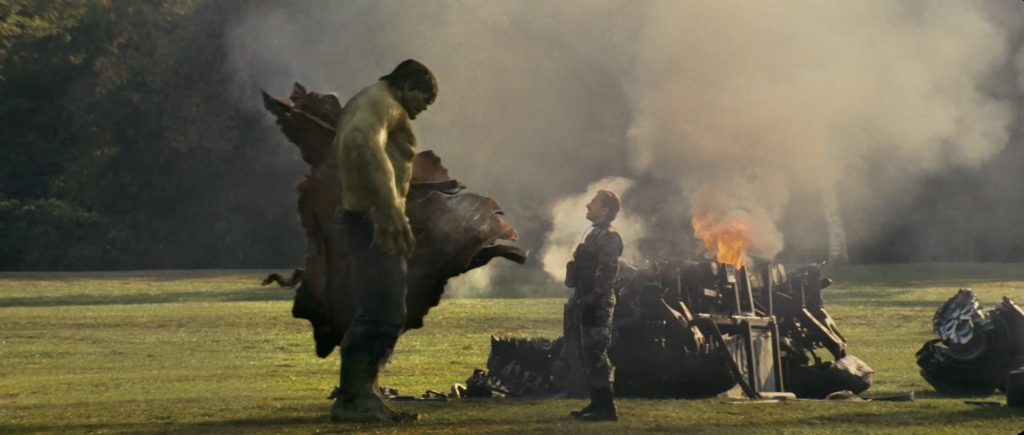In this weekly series, we chronicle the long road undertaken by the Marvel Cinematic Universe movies to arrive at Avengers: Infinity War. We introspect and discuss the movies from a critical and commercial standpoint while also considering the development efforts that went behind them. These articles may be occasionally sprinkled with spoilers so please make sure to skip the relevant sections when reading.
This post is about the 2008 movie The Incredible Hulk, the second chapter in the Marvel Cinematic Universe.
It was early days for Marvel Studios. While Iron Man had proven to be a resounding success, the studio as a whole was still a new entrant. Perhaps this afforded them the liberty of releasing two of their superhero adaptations so close to each other. Or perhaps it was the fact that Universal Studios had a lot more vested in The Hulk than Paramount did in Iron Man. Nevertheless, The Incredible Hulk rolled out in theaters on Jun 13, 2008 to what was then termed as a moderate success although in hindsight, it could easily be passed off as a box-office disappointment. It’s $263 million worldwide haul would’ve barely made back its production and marketing budget, especially when theater cuts and distribution costs are factored in.
Then again, this Hulk was coming off after an already disappointing Hulk movie. Ang Lee’s 2003 Hulk was a rather different take on the character. More verbal than visual, it leaned heavily towards the struggle and inner conflict between Banner and his Frankenstein alter-ego, to the extent that audiences get to see the Hulk fully formed only in the movie’s third act. Understandably, a viewership fed on a diet of Hulk Smashing could not digest this and it ended up scoring badly with viewers. Surprisingly, it still managed a $245 million worldwide gross against a more or less similar budget back in 2003 so it’s a bit confounding for it to be considered a flop in the traditional sense.
Marvel however felt that the nature of Hulk’s character demanded an action movie or at the very least, a movie with action sequences. It was important to tease and build-up to the Hulk’s introduction but not so much to have him introduced in the movie’s final act. It was equally important to show Bruce Banner as a man on the run after an abnormal exposure to gamma radiation which, in the movie, he inflicts upon himself as some form of lab-rat experimentation. And it was also necessary to avoid repeating an origin story in the traditional sense, a route which Marvel would later on also take with its other beloved character Spider-Man.
The result is a movie that pretty much sums up the mythos of the Hulk during the opening credits. Rumor has it that around 70 minutes of footage was shot to show the Hulk’s origin, which the editors working with director Louis Leterrier then cut down and assembled into the opening montage that lasts a few minutes. With the origin out of the way, the movie then focuses on achieving its other objective of showing a man on the run. We thus enter Bruce Banner living in isolation in Brazil opening with a shot of the crowded houses built atop layers upon layers that lingers on for a tad longer than it should but helps us soak in the claustrophobic setting. What follows are sequences depicting Banner going on about his daily life which include taking Jiu Jitsu training from acclaimed master Rickson Gracie, watching television, working as daily labor in a bottle factory (something which is clearly beneath his qualifications) and searching for a possible cure to his condition, chatting with a certain Mr. Blue using the alias Mr. Green evoking the colored men of Reservoir Dogs, all this while constantly checking his pulse to prevent a Hulk transformation. The movie is largely visual during these sequences and they’re a delight to watch in how artfully they manage to convey information surpassing the language barrier. These are truly some of the finest sequences in the movie and every time I watch it, I often find myself wondering what truly was not to like in this movie. As the movie unfolds, it becomes clear why.
 Considering the Hulk to be a property of the US Government, General Thunderbolt Ross, played superbly by the talented William Hurt, launches an obsessive manhunt, keeping track of anything that could lead them to Banner. He has overenthusiastic Emil Blonsky by his side, itching to get his hands dirty on a fight. They depart to Brazil when Banner’s blood dropping on one of the bottles causes an infection leading them to the factory and effectively to Banner who flees. The whole chase sequence is nicely filmed and ends in Banner Hulking out although it’s too early for us to see him fully formed. Realizing Brazil is no longer safe, he somehow makes his way back home where he ends up unable to escape the eyes of his comic-book love interest Elizabeth “Betty” Ross.
Considering the Hulk to be a property of the US Government, General Thunderbolt Ross, played superbly by the talented William Hurt, launches an obsessive manhunt, keeping track of anything that could lead them to Banner. He has overenthusiastic Emil Blonsky by his side, itching to get his hands dirty on a fight. They depart to Brazil when Banner’s blood dropping on one of the bottles causes an infection leading them to the factory and effectively to Banner who flees. The whole chase sequence is nicely filmed and ends in Banner Hulking out although it’s too early for us to see him fully formed. Realizing Brazil is no longer safe, he somehow makes his way back home where he ends up unable to escape the eyes of his comic-book love interest Elizabeth “Betty” Ross.
It’s here that the movie begins to flounder, at least for me. From here on, the focus shifts from Banner and his run to the love story between Betty and Banner. The problem is, Betty isn’t really written as much of an interesting character and comes across as the classic damsel-in-distress, waiting for her true love to return notwithstanding her already existing relationship with a Leonard Samson. Suspicious of Banner’s motives, Samson gives away his location when he’s at a University looking for data pertaining to the gamma project that caused his condition. This leads into one of the movie’s better action sequences where we see the Hulk fully formed smashing military vehicles and fighting a now charged up Emil Blonsky, who at this point has been injected with a small dosage of a serum that could grant him Hulk like abilities.
 Somewhere amidst the action and chaos, the movie loses its stride. There are good and delightful scenes peppered through the film but it fails to connect as a whole or even have a central story for that matter. The climactic battle between a fully Hulked-up Blonsky now known as The Abomination and The Hulk is, while an impressive fight, ultimately just that and nothing more. The movie ends though with two open-ended stingers which offer a range of possibilities in the future and both go on to play a role in the MCU’s upcoming ventures.
Somewhere amidst the action and chaos, the movie loses its stride. There are good and delightful scenes peppered through the film but it fails to connect as a whole or even have a central story for that matter. The climactic battle between a fully Hulked-up Blonsky now known as The Abomination and The Hulk is, while an impressive fight, ultimately just that and nothing more. The movie ends though with two open-ended stingers which offer a range of possibilities in the future and both go on to play a role in the MCU’s upcoming ventures.
Perhaps one of the movie’s strengths lies in having secured Edward Norton to play the titular role. Not only does he perfectly project the vulnerability, pain and inner turmoil that Bruce goes through in attempting to suppress the Hulk, often doing all that just through his eyes, but he also ended up adding significantly to the movie by rewriting the script. Among his additions included the interactions between Mr. Blue and Mr. Green and his attempts at testing the flower for a cure. It’s a shame Norton didn’t stick around to play The Hulk (then again, the one playing him right now is even better). Norton successfully lends a gravitas to the role that the character rightfully needs. At the other end is William Hurt who excellently portrays an obsessiveness in wanting to get his hands on Banner, often exercising restraint before launching into full megalomaniac mode at times. Tim Roth is also convincing as the power hungry Emil Blonsky; he conveys brilliantly Blonsky succumbing to his body’s desires in wanting to max out his capabilities.
 As would be the case with all Marvel Studios movies, The Incredible Hulk shines on the technical front although there are shortcomings that become apparent upon re-watches. The visual effects for Hulk for instance, look less convincing in some shorts and the composition seems off in certain sequences as do the physics which have the Hulk and the Abomination duking out way too fast than bodies of their size would permit. Musically, John Debney gives some memorable tunes, my personal favorites being ironically Betty and Banner’s romantic theme and a small piece in the climactic fight which sees Hulk return to form after being pinned down by the bone-protruding creature.
As would be the case with all Marvel Studios movies, The Incredible Hulk shines on the technical front although there are shortcomings that become apparent upon re-watches. The visual effects for Hulk for instance, look less convincing in some shorts and the composition seems off in certain sequences as do the physics which have the Hulk and the Abomination duking out way too fast than bodies of their size would permit. Musically, John Debney gives some memorable tunes, my personal favorites being ironically Betty and Banner’s romantic theme and a small piece in the climactic fight which sees Hulk return to form after being pinned down by the bone-protruding creature.
What also comes across as a surprise is really how much was left out on the cutting room floor. The movie has 45 minutes worth of deleted scenes and most of them would’ve been better left in the movie. These scenes add significantly to the characters, most notably Banner, General Ross and Blonsky and provide them with the much needed dimension that was missing from the final edit. I suspect the Marvel committee at the time could’ve been behind these decisions, wanting to keep the movie’s scope restricted to that of a simple action-movie.
I suppose one of the reasons The Incredible Hulk is considered to be a better box-office performer than Hulk has to do with expectations. The latter came out in 2003 at the peak of the superhero movie explosion and, being the first live-action Hulk film, had audiences insanely hyped up. Fast forward 5 years ahead and in 2008 we have the same audiences already exposed to Spider-Man 2, X2: X-Men United, Fantastic Four, Batman Begins and the recently released Iron Man with The Dark Knight expected to hit theaters next month. By all accounts, audiences had probably seen much and went in with tempered expectations. It didn’t help that the movie had not absolutely distanced itself from Ang Lee’s Hulk with producers Kevin Feige and Gale Anne Hurd often referring to it as a kind of a requel i.e. a reboot and a sequel. Audiences thus went in without hoping for anything fun and came out entertained leading to a similar gross as the 2003 movie. The Incredible Hulk thus under-promised and over-delivered whereas Hulk over-promised and under-delivered.
 In the end, despite its highs, The Incredible Hulk remains at best a decent entertainer. It’s not a bad film by any means but it doesn’t break new ground or stretch the boundaries of what’s possible with the superhero genre. What it is though is a decent superhero movie that shines in a few spots but doesn’t have enough brightness in it to merit a strong rating. Interestingly, it also gives us our first taste at what a Marvel crossover could truly feel like when a certain someone shows up at the end to recruit members for a team that’s being put together.
In the end, despite its highs, The Incredible Hulk remains at best a decent entertainer. It’s not a bad film by any means but it doesn’t break new ground or stretch the boundaries of what’s possible with the superhero genre. What it is though is a decent superhero movie that shines in a few spots but doesn’t have enough brightness in it to merit a strong rating. Interestingly, it also gives us our first taste at what a Marvel crossover could truly feel like when a certain someone shows up at the end to recruit members for a team that’s being put together.
And now, on to the next one.





